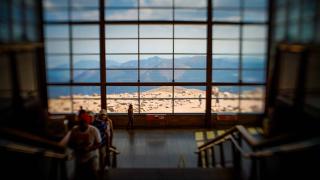USDA Forest Service employee Preston Keres takes us on a tour of the new Pikes Peak Visitor Center. (USDA Forest Service video by Preston Keres)
Rising to 14,115 feet, Pikes Peak is a landmark that has inspired travelers, poets and locals for generations. Towering over the city of Colorado Springs, Colorado, it is also home to a visitor’s center that seamlessly blends history and recreation, reflecting the best of what partnerships can achieve.
Every year, thousands of people from around the world make the trip to Pikes Peak. Families drive up the highway, hikers conquer Barr Trail, and bikers test their endurance. Each arrival reinforces what the center stands for: a showcase of partnerships and a promise to our future.

When forest and grassland supervisor Ryan Nehl walks through the center, he does not just see a building; he sees a place where people begin to understand what this land means, its past, its challenges, its continued beauty, relations with tribes and the partnerships that enable all of this to happen.
“We rely heavily on the city of Colorado Springs to manage the visitor center as well as the road that goes to the summit,” he explained. “This is an invaluable relationship that we’ve had for almost 100 years.”

Felt for generations
From ramps and interpretive exhibits to outdoor terraces that open onto the Rockies, every aspect was designed so that all guests can experience the story of Pikes Peak.
Key to visitors’ experiences on the mountain is the continued role of indigenous nations in the mountain's stewardship and the visitor center. “The Forest Service recognized what tribes have been telling us all along,” says Forest Service Tribal Liaison Dr. Jason Herbert, “that when the first caretakers of the lands are engaged with the management of these spaces, everyone wins.”

Pikes Peak remains critical to numbers of tribes, including the Ute, Kiowa, Jicarilla Apache, Pawnee, Cheyenne, Arapaho and Comanche peoples. The new visitor center is, in some ways, a physical manifestation of renewed efforts to strengthen relations between the Forest Service and tribes whose ancestral homelands are within Colorado, with 2025 marking the third annual sunrise ceremony at the top of Pikes Peak.
District Ranger Carl Bauer understands the importance of partnerships within the community in making the work they complete every day possible.
“Partnerships are a big deal for the Pikes Peak Ranger District; it’s one of the reasons I wanted to become the district ranger here,” Bauer said. “There are more than 30 partners in the area that are well organized and well-funded, and they help us achieve our mission every day.”

While the U.S. Department of Agriculture's Forest Service is the steward of the land, the city of Colorado Springs, tribal and local partners all played critical roles in shaping the center. From planning and funding to daily operations and trail maintenance, it has been a shared effort that will be felt for generations.
“I can’t tell you how incredible it is to work with Forest Service employees,” said Britt Haley, Director of Parks, Recreation and Cultural Services for the city of Colorado Springs. “We are making sure that we have good land management and stewardship, that we are taking care of the people’s property, and that people get to recreate on and enjoy this incredible scenery up here on Pikes Peak.”
Governor Jared Polis also sees the center as part of a much larger tradition of cooperation.
“Here in Colorado, the Forest Service owns a lot of our land, and there’s a long history of partnerships there,” he said. “When you go skiing at world-class resorts, that is Forest Service land. By working with our Colorado Parks and Wildlife and our state parks and collaborating with the Forest Service, we can really upgrade the experience that people have visiting these amazing sites.”

(Top) The new state-of-the art Pikes Peak Summit Visitor Center, which looks unassuming sitting atop the mountain, opened in June of 2021 and exposes guests to immersive exhibits to explore the geology, ecology, and cultural heritage of Pikes Peak. (Bottom left) Guests step out onto the scenic overlook deck; a sweeping, open-air platform, that are not only accessible and protected walkways but offer safe routes for site seeing. (Bottom right) The view from Pikes Peak inspired a Katharine Lee Bates poem that eventually became the lyrics to the song “America the Beautiful. (USDA Forest Service photos by Preston Keres)
More than a building, it’s a commitment
Inside the Pikes Peak Summit Visitor Center, floor-to-ceiling windows that frame the horizon are met with the smell of fresh donuts from the café. Walk a little farther, and the center opens into a space telling the story of Pikes Peak. The exhibits dig deeper into the mountain, explaining how alpine plants and animals survive in the thin air and how the mountain was shaped over millions of years.
Stepping outside is its own experience. The top of the mountain offers a 360-degree view that sweeps from the Rockies to the Great Plains, with a display that reminds visitors that this was the view that inspired the words to “America the Beautiful.”

Every design choice was deliberate, encouraging people to slow down and experience natural beauty.
The center also set a new standard for sustainability. From energy-efficient design to water conservation, every detail was chosen to protect the ecosystem. It is a modern facility that still blends seamlessly into its surroundings, proof that innovation and land management work hand in hand.
The visitor center is more than just a building at the top of a mountain; it is a commitment to partnerships and shared stewardship, and it is proof that caring for the land remains a special place for generations to come.
Subscribe to our newsletter to keep up with all Forest Service feature stories!







